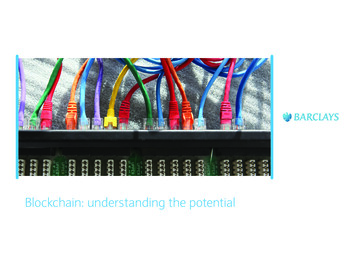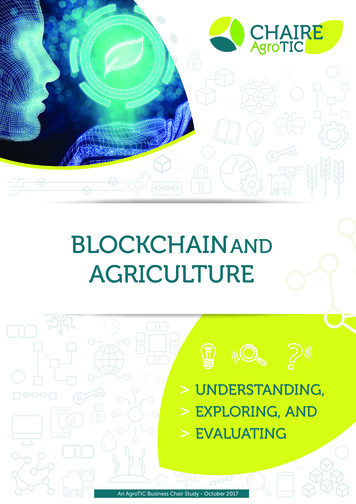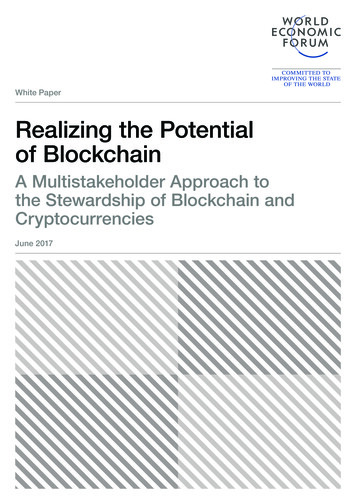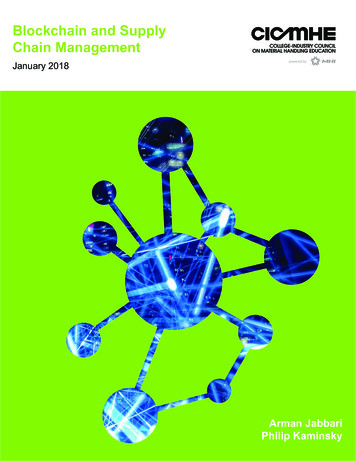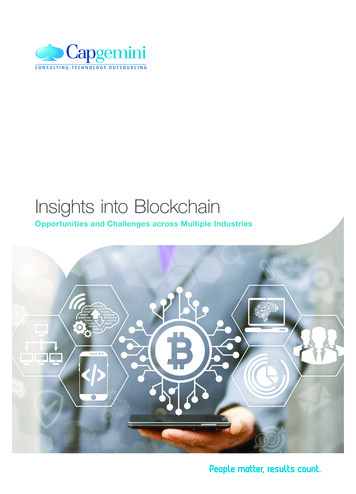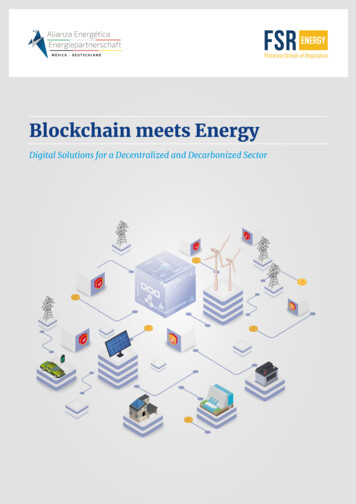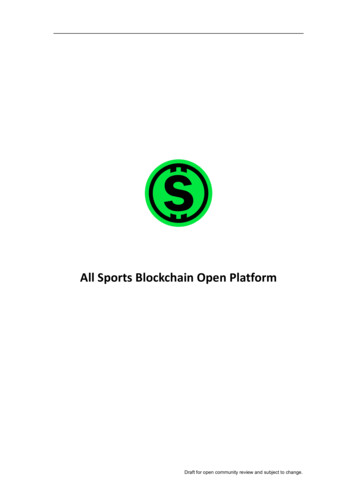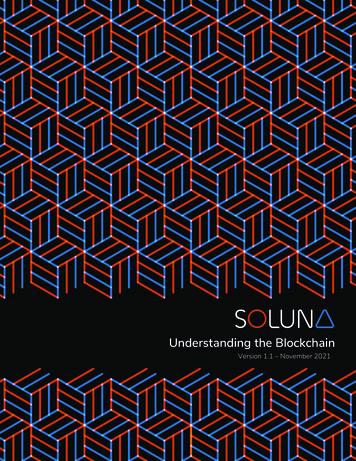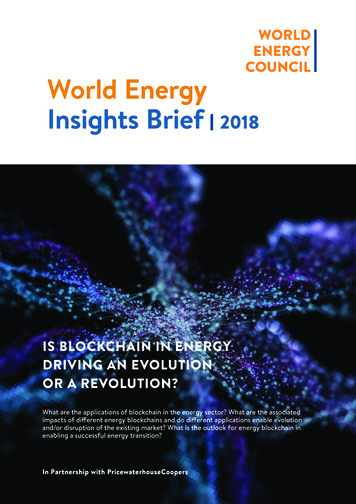
Transcription
World EnergyInsights Brief2018IS BLOCKCHAIN IN ENERGYDRIVING AN EVOLUTIONOR A REVOLUTION?What are the applications of blockchain in the energy sector? What are the associatedimpacts of different energy blockchains and do different applications enable evolutionand/or disruption of the existing market? What is the outlook for energy blockchain inenabling a successful energy transition?In Partnership with PricewaterhouseCoopers
ABOUT THE WORLD ENERGY COUNCILThe World Energy Council is the principal impartialnetwork of energy leaders and practitioners promotingan affordable, stable and environmentally sensitiveenergy system for the greatest benefit of all.Formed in 1923, the Council is the UN accredited globalenergy body, representing the entire energy spectrum,with over 3,000 member organisations in over 90countries, drawn from governments, private and statecorporations, academia, NGOs and energy stakeholders.We inform global, regional and national energy strategiesby hosting high-level events, including the World EnergyCongress and publishing authoritative studies, and workthrough our extensive member network to facilitate theworld’s energy policy dialogue.Further details at www.worldenergy.organd @WECouncilPublished by the World Energy Council 2018Copyright 2018 World Energy Council. All rightsreserved. All or part of this publication may be used orreproduced as long as the following citation is includedon each copy or transmission: ‘Used by permission of theWorld Energy Council’World Energy CouncilRegistered in England and WalesNo. 4184478VAT Reg. No. GB 123 3802 48Registered Office62–64 CornhillLondonEC3V 3NHUnited KingdomABOUT THIS INSIGHTS BRIEFThis Insights Report on energy blockchain is part of aseries of publications by the World Energy Council focusedon Innovation, with the aim of facilitating strategic sharingof knowledge between the Council members and the other energy stakeholders and policy shapers in a fast-pacedera of disruptive changes.www.worldenergy.org/
BLOCKCHAIN IN ENERGYEVOLUTION OR REVOLUTION?TABLE OF CONTENTSBLOCKCHAIN INSIGHTS: AN ANTHOLOGY OF INTERVIEWS 5Entities Interviewed by the World Energy Council and PwC 5INTRODUCTION 6KEY INSIGHTS 6BLOCKCHAIN USE CASES – BEYOND THE HYPE 10Using Blockchain for Flexible Trading Platforms Blockchain for Energy Trading Systems Blockchain for Supply Chain Tracking Blockchain for E-mobility Blockchain for Tokenisation and Project Financing 1113141516Blockchain for Bitcoin Mining Blockchain for Peer-to-Peer Trading An Alternative to Blockchain – Emergent 171722CHALLENGES TO ADOPTION 24Technological challenges are being actively resolved Consumer Apathy Remains a Challenge Mixed perspectives on regulatory constraints and enablers 242425RECOMMENDATIONS FOR REGULATORS AND POLICYMAKERS 27 FUTURE OUTLOOK 29ANNEX 1 – FULL RESPONSES FROM A REPRESENTATIVE SAMPLE OF INTERVIEWEES 31ANNEX 2 – INTERVIEWEE CREDITS 34PROJECT TEAM 353
WORLD ENERGY COUNCIL BLOCKCHAIN INSIGHTS BRIEF 2018BlockchainInsightsAnthology ofInterviews4
BLOCKCHAIN IN ENERGYEVOLUTION OR REVOLUTION?BLOCKCHAIN INSIGHTS: AN ANTHOLOGY OFINTERVIEWSThis Insights Report on energy blockchain is part of a series of publications by the World Energy Councilfocused on Innovation, with the aim of facilitating strategic sharing of knowledge between the Councilmembers and the other energy stakeholders and policy shapers in a fast-paced era of disruptive changes.This Insights Report has been produced by the Council in partnership with PwC, with additionalsupport provided by the Council’s Future Energy Leaders group. It follows on from a previous jointpublication by the Council and PwC, “The Developing Role of Blockchain,” issued in 2017.The insights conveyed hereafter are underpinned by the valuable learnings from a series of 39interviews conducted with key leaders across the energy sector hailing from around the globe.The interviewees include well-stablished energy incumbent players in the electricity and oil & gasindustries, as well as technology providers, start-ups, regulators and think-tanks, all actively engagedwithin the blockchain space. The broad participation from different areas of the energy market waspurposely pursued to ensure this publication could provide a reliable and relevant snapshot in time ofthe current state of progress of various blockchain activities within the sector.We asked the interviewees ten questions. The two key questions posed were: How far along isblockchain, and is regulation an impediment to its progress?Below is a list of the interviewees. We would like to take this opportunity to thank each of them fortheir participation.Entities Interviewed by the World Energy Council and PwC:General ElectricWePowerSiemensIBMEngieEquinorSP GroupEnelTEPCO VenturesTeriPG&ECPUCElectronDCCAEFaraday GridIERCFlexitricityNational Grid UKWiproMotionWerkTennetEDPSunrunVervLO3 EnergyRocky Mountains InstituteFreelioEnergoLabsAllgauHive PowerTEPCO (Trendy)Power LedgerInnogy Innovation Hub, InnogyEnergy Impact PartnersGerman Energy Agency (dena)FutureFuel TechArizona CorporationCommissionEnergy Web FoundationNew Zealand ElectricityAuthority5
WORLD ENERGY COUNCIL BLOCKCHAIN INSIGHTS BRIEF 2018INTRODUCTIONThe use of blockchain technology within the energy sector (“energy blockchain”) is emerging as akey strategy and focus area for modernisation of the industry. As a distributed ledger technology(DLT), blockchain provides a platform for the management and transaction of high-value data. Unlikeother DLTs, however, blockchain is “trustless”1, requiring no intermediaries and, thus, it brings thepotential to catalyse the existing business processes as well as a reduction of the overhead costs andlevel of complexity embedded in the current energy ecosystem.Utilising blockchain technology to optimise the existing practices of the energy sector throughasset traceability applications and other behind-the-scenes technology upgrades are obvious choicesfor the energy sector. It will not be surprising to see such applications appear soon on the horizon.The open question about blockchain is, can it revolutionise the way residential consumers consumeand receive electricity?The intent of this anthology is to showcase what the different companies and participants engagingwith emerging blockchain technology are aiming for and what progress has been made to date withtheir applications. We can also leverage their insights to gauge blockchain’s impact on the sector.KEY INSIGHTSBased on the 39 interviews, a clear majority (85%) of participants agreed that blockchain has notyet attained a commercially tangible impact, though it has certainly been spurring the effortsand investment of many stakeholders across the energy sector. The majority also agreed thatenergy blockchain has not yet led to changes in business models nor enabled a clear shift from thetraditionally centralised electricity grid.1.The term “trustless” is commonly used in describing blockchain technology, whereby there are mechanisms in placeby which all parties in the system can reach a consensus on what the established truth is, without intermediaries. Powerand trust is distributed (or shared) among the network’s stakeholders (e.g. developers, miners, and consumers), ratherthan concentrated in a single individual or entity (e.g. banks, governments, and financial institutions).6
BLOCKCHAIN IN ENERGYEVOLUTION OR REVOLUTION?SOLUTION LOOKINGFOR A PROBLEMRICHARD DOWLING,FARADAY GRIDBLOCKCHAIN IN THEENERGY SPACE IS STILLIN AN EMBRYONIC STATE ,COMPARABLE TO THE VERYEARLY DAYS OF THE INTERNETREVOLUTIONJON CREYTS, RMI7
WORLD ENERGY COUNCIL BLOCKCHAIN INSIGHTS BRIEF 2018The maturity model, Figure 1 shown below, is based on the responses gathered throughout theinterview process. As can be seen, the majority of interviewees (67%) attributed a maturity levelthat is reaching early adoption phase, when considering the global developments in blockchainapplications to date. This is not to suggest individual pilots are not more advanced. Rather, the modelillustrates the actual, currently limited maturity of blockchain thus far in the energy sector.Figure 1: Maturity ModelUnanimously, the interviewees agreed that while blockchain has catalysed great efforts in theinnovation space from a wide number of organisations in the energy sector, much is yet to be doneto ascertain the effectiveness of the technology and its full economic/technological viability.We don’t think that blockchain has delivered a real direct value just yet in the energysector. However, the concept has given the industry a trigger to rethink how to tradeand manage the creation and distribution within the value chain.Audrey Lee & Chris Moris, SunrunThere was also broad agreement among the interviewees that while blockchain technology iscertainly a very promising tool, and perhaps an accelerant for decentralisation, it is not an essentialrequisite for decentralisation and democratisation of energy.8
BLOCKCHAIN IN ENERGYEVOLUTION OR REVOLUTION?With or without blockchain the energy system will continue to move towarddecentralisation and democratisation.Alastair Martin, FlexitricityThe energy sector is going towards decentralisation and democratisation. Blockchainis a technology enabler, but there are other macro-forces that are shifting the energyworld in that direction. There are other technologies which may serve the purpose, butblockchain is well suited when we consider direct transactions between users, hence it isa strong catalyst towards decentralisation and democratisation.May Liew, SP GroupBlockchain – Some Misconceptions to be DispelledAhead of discussing some of the use cases it is worth dispelling some of the misconceptions aboutblockchain technology in the energy space.2MisconceptionsRealityBlockchain is BitcoinBlockchain is not Bitcoin. Bitcoin was created in 2009and is a cryptocurrency application of blockchain,whereas blockchain technology, as the underlyingprotocol, has many different potential applications.Blockchain is energy-intensiveBitcoin is extremely energy-intensive, but there isalternative blockchain technology developed in 2017which is not based on mining that requires significantcomputational power. Public and private Ethereumbased Proof-of-Authority solutions, Hyperledger andothers are using a different process to reach consensus.Blockchain is 100% tamper-freeBlockchain is not 100% tamper-free. The immutabilityof data on a chain has been one of the key selling pointsfor blockchain among enthusiasts and innovators. Infact, the complete immutability of the data cannot beguaranteed entirely. Data can potentially be modified,once written. However, since this would be a ratherexpensive process, tamper within a blockchain isn’teconomically /media/Downloads Dateien/esd/9165 Blockchain in derEnergiewende yths-blockchain/9
WORLD ENERGY COUNCIL BLOCKCHAIN INSIGHTS BRIEF 2018Blockchain can verify the accuracy and validity ofexternal dataBlockchain cannot verify the accuracy or veracity ofexternal data. It can only verify all the data entirelycontained on, or generated within the blockchain itself.Blockchain is the best database out thereBlockchain isn’t necessarily better than traditionaldatabases. It is particularly useful in a low-trustenvironment, where it removes the need forintermediaries and allows for participants to tradedirectly.Smart contracts are legally bindingSmart, self-executing contracts, powered by blockchainplatforms, require no intermediaries. However, “codeis not law” and smart contracts are not legally bindingwithout separate contractual agreements.BLOCKCHAIN USE CASES – BEYOND THE HYPEAttractive promises continue to be attributed to blockchain, hailed by many as the game changerthat will entirely transform the energy value chain, leading to the creation of new business modelsand a transformation from consumers to prosumers. However, use cases beyond proof-of-conceptare still very limited (at best), making it difficult to envision the highly anticipated leap from meretesting environment to the real world.Figure 2, below, illustrates the breakdown of use cases currently in progress. As can be seen, themajority of companies interviewed, approximately 45%, are trialling Peer-to-Peer (P2P) projectsaimed towards optimisation of the existing grid. Notwithstanding this notable dynamism surroundingP2P, there further exists a plethora of promising evaluations taking place in other areas of thesector, any and/or all of which, particularly given the nascent development of all the use cases, haveopportunity to emerge as significant applications for blockchain.10
BLOCKCHAIN IN ENERGYEVOLUTION OR REVOLUTION?Figure 2: Different Types of Uses for Energy BlockchainAccordingly, this section identifies seven types of uses of blockchain technology currentlyundergoing trial across the globe with varying degrees of maturity and early adoption. The follow-upto this Brief will identify and discuss in detail a number of relevant energy blockchain use cases andtheir potential impact on the energy ecosystem. FLEXIBLE TRADING PLATFORMS FOR DISTRIBUTED ENERGY RESOURCES EMISSIONS TRADING SYSTEMS SUPPLY CHAIN TRACKING E-MOBILITY TOKENISATION AND PROJECT FINANCING BITCOIN MINING PEER-TO-PEER TRADINGIn addition, Faraday Grid is piloting an alternative technology in order to make the existing grid morerobust and reliable, and to promote further inclusion of renewable energy sources across the grid. EMERGENTUsing Blockchain for Flexible Trading PlatformsElectron, a U.K.-based start-up, has been working towards the creation of a new, digitalised energymarketplace, able to include smaller Distributed Energy Resources (DERs) alongside incumbentutilities, and cater for a more cost competitive, transparent and modern energy system. The Electronflexible trading platform applies blockchain technology to grid optimisation.It (the platform) helps create visibility over billions of dollars of untapped value in gridedge assets and coordinates these assets’ participation across multiple energy markets,whilst removing the requirement for a monopoly trusted intermediary.Jon Ferris, Electron, U.K.A requisite for this platform to be successfully implemented is the creation of an Asset Register,to provide a full map of each generating asset/device behind the meter. According to Electron, a11
WORLD ENERGY COUNCIL BLOCKCHAIN INSIGHTS BRIEF 2018shared asset register would see different parties responsible for sharing their data. Blockchain, as aDLT, can allow recorded data to be available to all participants equally, thereby facilitating sharingamong multiple parties who have interest in the same information/data.Figure 3: Electron PlatformIn today’s system there is already rapidly building demand for this type of platform. Thanks in nosmall part to policies and incentives aimed towards promoting greater renewable energy supply, overrecent years there has been an increase in DER installations all over the world. These small capacityassets are connected to low and medium voltage grids and can be behind the grid or connected tothe main distribution system. Surging numbers of such distributed energy assets, with their variable,weather dependent power profiles coupled with increased, likely localised electricity demand,require more interventions to manage power quality and availability in grid systems.The inclusion of smaller, more diverse generating assets into the current energy system also requiresnew communication infrastructures to grant more choice and more control to the consumer overher energy choices.Central dispatch is no longer an efficient solution to an increasingly complex problem.Moreover, data collection, storage, access permissions, and security are key challenges.[ ] Democratic and inclusive marketplaces, through which thousands of smaller energy12
BLOCKCHAIN IN ENERGYEVOLUTION OR REVOLUTION?assets might be connected and integrated with large incumbent utilities, will optimisethe costs and carbon efficiency of the energy system.Jon Ferris, Electron, U.K.The potential benefits of Electron’s blockchain-powered flexible trading platform are attractiveto several stakeholders in the energy value chain, such as system and transmission operators,distribution network operators, aggregators, traders, EV charging companies, battery managementcompanies and energy retailers. Hence the creation of the recently announced Electron-ledconsortium backed by, amongst others, National Grid U.K. and Flexitricity.One of the issues faced by the U.K. energy sector today is metering which measures thecontribution of demand-response and could be potentially contaminated by unrelatedfactors. Sub-metering is key and would allow us to determine the correct level ofenergy delivery at site, but this requires appropriate information flow and validation.Blockchain technology has the potential to be able to address this issue successfully andenable us to fully optimise demand-response.Alastair Martin, FlexitricityWith continued improvement of DER technologies, alongside the decreasing cost of storagedevices, blockchain-powered DER markets could provide a quick response for market balancing.Regulators are also expected to gain benefits from the Electron platform by having better marketvisibility and integrating governance processes into the platform. Electron is currently at proof-ofconcept stage and estimates that it will have reached full commercial implementation in the U.Kwithin 18 months’ time.Blockchain for Energy Trading SystemsSP Group has developed a blockchain-powered Renewable Energy Certificate (REC) platform.This is one of the first global REC platforms powered by blockchain which brings togetherrenewable originators and buyers, with the goal of integrating more renewable sources of any sizeinto the energy system. Having an open-source, global blockchain infrastructure will encouragestandardisation across geographies, thereby enabling frictionless cross-border REC transactions.Blockchain technology can record trade certificates, providing a reliable verification process andwithout the need for an expensive centralised management entity. Renewable Energy Certificatesystems can also be designed in a standardised manner by using a uniform set of rules enforced bythe blockchain.13
WORLD ENERGY COUNCIL BLOCKCHAIN INSIGHTS BRIEF 2018We believe that blockchain is the optimal technology to enable RECs transactionsas it can empower buyers and sellers to achieve their sustainability goals at nationaland global levels. Our goal is an REC platform using blockchain technology which willenable differentiators, such as empowering buyers and sellers of any size, thereforedemocratizing the marketplace.May Liew, SP GroupThe SP Group RECs platform is currently in a pilot stage, on track towards first phase of commercialimplementation by the end of 2018.On the other side of the globe, Pacific Gas & Electric (PG&E) is working on a similar development.PG&E is currently developing a blockchain application to attribute electric vehicle chargingsessions directly to on-site or grid renewables, generating a carbon credit that can be traded on anexisting marketplace. Through this application, smart contracts are expected to generate carboncredits for EVs, based on a variety of factors which include: hourly grid carbon intensity, amount ofon-site renewable generation, customer’s tariff and charge event data. PG&E also plans to explorethe feasibility of utilizing blockchain to enable customers to receive carbon credits, and then sellthem in the market to companies who need to buy them to fulfil regulatory requirements3. PG&Eexpects to reach full commercial implementation in California within the next 3-5 years, albeitdepending upon establishment of an appropriate regulatory framework.This project would change the way the current market works by eventually replacingthe centralised web-based tool that tracks assets with distributed credits/tokens as anaccounting method. It would provide unique IDs for each credit generated, which wouldfurther help regulators reduce double counting/double spend in the market.Lydia Krefta, PG&BBlockchain for Supply Chain TrackingThough blockchain was originally developed for sectors not involving the physical exchange ofgoods (i.e. banking and finance), many applications have been emerging where blockchain is usedto optimise the processes behind physical exchanges. An example of this is commodity trade whichinvolves multiple exchanges of data (at times manually) to clear and process transactions. In thisarea, blockchain applications are being piloted in the oil & gas sector through a joint-venture3.California’s cap-and-trade program, launched in 2013, is one of a suite of major policies the state is using to lowerits greenhouse gas emissions. The program sets a limit (cap) on the total amount of greenhouse gases that can be emitted. Companies then buy or sell (trade) permits to emit these gases, primarily carbon dioxide CO214
BLOCKCHAIN IN ENERGYEVOLUTION OR REVOLUTION?between IBM and Maersk. Their aim is to remove intermediaries, increase efficiencies acrossinternational supply and value chains, have better visibility and reduce asset loss from productionto consumption. The Global Trade Digitisation (GTD) blockchain pilot enables paperless trade bydigitizing and automating document workflow. It also allows for companies to trace assets moreeffectively. With 1.8 trillion worth of goods traded across international borders annually, IBM andMaersk expect to achieve savings of 10% through their blockchain digitised processes.The Global Trade Digitisation (GTD) is a trade platform connecting the entire supplychain. GTD is built on an open technology stack and is underpinned by blockchaintechnology. It is the platform underpinning WP23 of the European Commission COREinitiative.David Womack, IBMFull commercial implementation of this blockchain application is expected by the end of 2018.In the electricity sector, PG&E is also working on the development of a blockchain applicationfor electric utility asset management. They intend to develop several nodes across the supplychain and digitise electric assets, tracking transactions throughout the supply chain via blockchain.Transactions can include tests, asset movement, asset changes, and asset payment. At present, theasset relies on disconnected databases that track asset movement within each company’s sphere ofinfluence. Blockchain can enable all parties to share relevant data in one single source of truth.This project is at PoC stage and expected to be fully proven and implemented within the next 2-7years.Blockchain for E-mobilityE-Mobility has been on the rise with 200 million electric vehicles (EVs) expected to be in use by2030, resulting in 11.9 billion kW of peak capacity and US 98 billion of power consumption. Atpresent, there is a highly fragmented EV charging market. This leads to an uncomfortable driver’sexperience, an increased complexity of the settlement processes of EV companies, an overload ofthe grid and the under-utilisation of the infrastructure.MotionWerk, a German start-up, have developed “Share & Charge”, a blockchain application basedon a decentralised, open-source protocol for EV charging. This will enable EV users a seamless,smart and secure charging experience. Share & Charge is expected to benefit a number ofstakeholders by facilitating access to all charge points for EV drivers, providing an easy integrationof charge points and EVs into the network, as well as an easy payment and efficient settlementprocess between all parties.15
WORLD ENERGY COUNCIL BLOCKCHAIN INSIGHTS BRIEF 2018It’s all about people using the charging network. If blockchain holds up to its promises,the consumers will enjoy a more efficient charging process and lower costs.Dietrich Sümmermann, MotionWerkCurrently at pilot stage, Share & Charge is expected to reach full commercial implementation andgo live by mid-2019.Blockchain for Tokenisation and Project FinancingBlockchain applications are also emerging in the context of tokenisation for project financeof renewable energy projects. Medium size assets are ill suited for traditional asset-backedsecuritisation and not large enough for traditional project finance. Considering these limitations,the Energy Impact Bank (EIB) has been developing a blockchain-powered platform that enables,through tokenisation, a low cost, low friction alternative for access to broader, cheaper pools ofcapital due to improved transparency and liquidity.EIB’s platform is akin to an investment bank tuned to DERs’ scale and heterogeneity.[ ] We are currently at PoC stage and expect to attain full commercial implementationwithin the next 4-8 months.Amar Pradhan, EIBAnother financing pilot is from WePower, which has developed a platform where project developersfor renewable energy generation facilities can raise capital by selling part of their future energyproduction directly to energy consumers or investors upfront. This is achieved via smart energycontracts that define the amount of energy to be produced in the future by an asset and the sharesof equity amongst investors.We have been developing a blockchain application to help finance more renewableenergy projects by raising capital for developers during the early development/construction stages. We involve the participation of banks, buyers and generators. Ourapplication enables to secure capacity dispatch in advance, avoiding the need for largecapacity long-term contracts, or centralised intermediary entities. Moving towards awholesale energy market powered by blockchain is our ultimate vision.Nick Martyniuk, WePowerWePower’s solution is about to begin pilot phase in Estonia and other countries.16
BLOCKCHAIN IN ENERGYEVOLUTION OR REVOLUTION?Blockchain for Bitcoin MiningFutureFuel Technology, a U.K.-based start-up established in 2015, have developed two biofuel powerplants that supply to the U.K. National Grid. They utilise used cooking oil, no longer fit for humanconsumption, and convert it into bio-fuel, which is then fed into a generator for the production ofelectricity to be exported into the grid. In addition, this start-up has been developing a blockchainapplication to mine Bitcoin, working towards the creation of the first entirely off-the-grid Bitcoinmine in the U.K.Our blockchain application will allow for greater renewable energy into the U.K.market, reinforcing the move away from fossil fuels. [ ] We use waste cooking oilwhose provenance is fully certified, so we also provide this added environmental benefitthrough our bio-waste generating capacity.Liam Ray, FutureFuel TechnologyFutureFuel Technology are also aiming to explore the mining of other digital assets in the nearfuture.Blockchain for Peer-to-Peer TradingUndoubtedly the area of blockchain application with the most hype surrounding it, Peer-to-Peer(P2P) trading is the final concept to be explored in this section. P2P is the “talk” of the sector -theprospects for blockchain technology to make transactive energy a reality, to upend the frameworkof the grid and the energy sector as we currently know it.When conjoined with appropriate business models, blockchain’s ability to make transactions faster,simpler, and cheaper can allow for wider participation into the energy market, down to individualhouseholds. This is the objective of blockchain-powered peer-to-peer applications. In them, smartcontracts allow a blockchain to be programmed with a set of conditions that when met automaticallyprompt transactions, enabling producers, consumers and prosumers all to participate into a saleprocess based on price, time, location and the type of energy source.Two prominent start-ups, LO3 and Power Ledger, are extending significant effort towards thecommercial implementation of the P2P business model. In the case of LO3, with its USD 6M projectin collaboration with Siemens, a blockchain platform is in place to enable automated transactionsover micro-grid wires between producers (mainly households with rooftop solar PVs) and consumers(households with smart meters). It should be noted, though, that this microgrid is connected to theutility’s infrastructure.17
WORLD ENERGY COUNCIL BLOCKCHAIN INSIGHTS BRIEF 2018Our P2P projects are dependent on the main grid – wires and pipes that electricityflows into are a requirement. Power balancing comes from outside the LO3 application,and the main grid plays a main role. [.] Our current projects are all between the proofof-concept and pilot stage. More than pure peer-to-peer trading, I would refer to themas peer-to-market. Not every consumer/prosumer is interested in trading to anotherpeer. We have micro-grid communities where the prosumers trade with the grid for theenergy that meets his demand and sells to the grid any excess energy that he produces.Lawrence Orsini, LO3In the Brooklyn Microgrid, Siemens is providing LO3 monitoring and data analyticssystem to forecast the trades in the micro-grid, to better forecast demand/responseand pricing over a few hours span. We also enable parts of the grid to be operated inisland mode to ensure the highest possible reliability and optimisation of communitymarkets, through localised generation. Ultimately, the goal is to incentivise consumer &prosumer demand/generation according to grid capacity/overload and market situation.Constantin Ginet, SiemensPower Ledger has reached full commercial implementation in Australia with their P
alternative blockchain technology developed in 2017 which is not based on mining that requires significant computational power. Public and private Ethereum-based Proof-of-Authority solutions, Hyperledger and others are using a different process to reach consensus. Blockchain is 100% tamper-free Blockchain i

